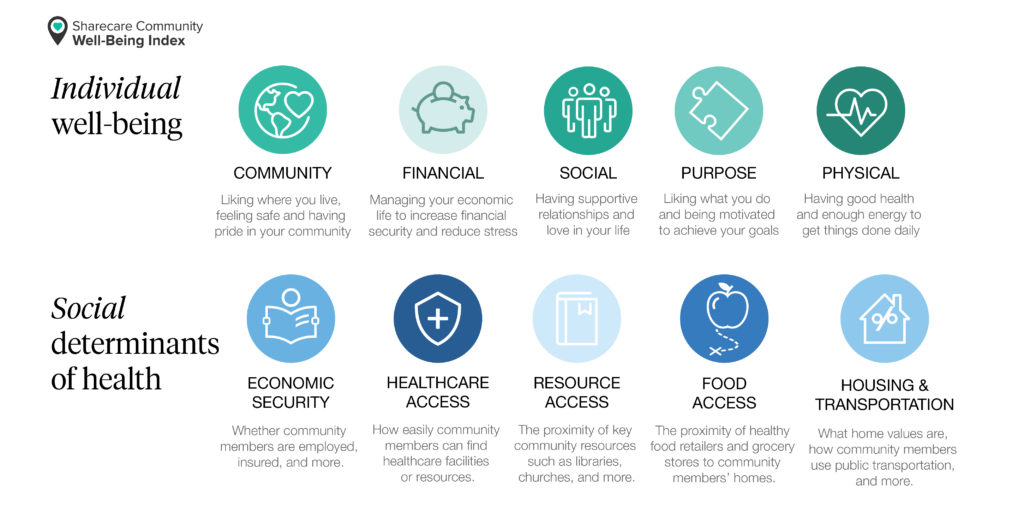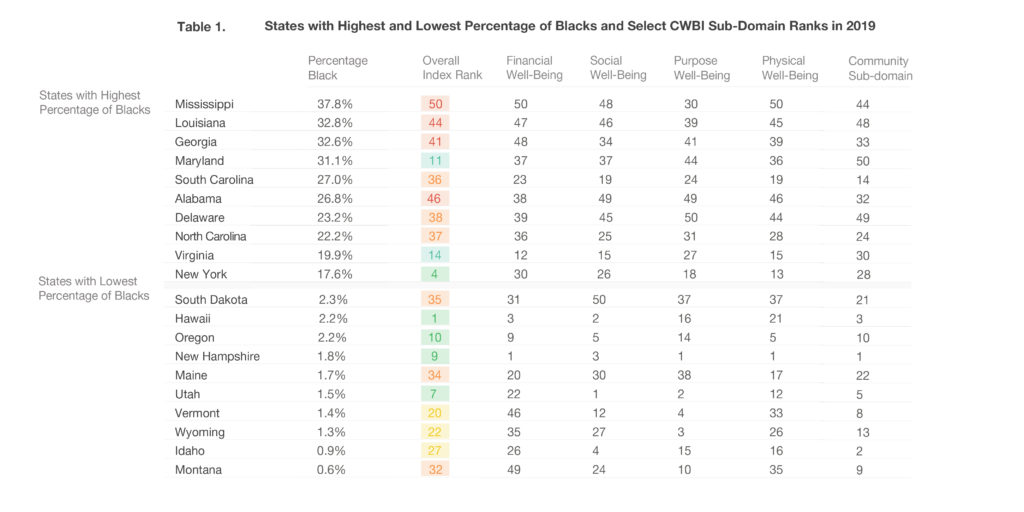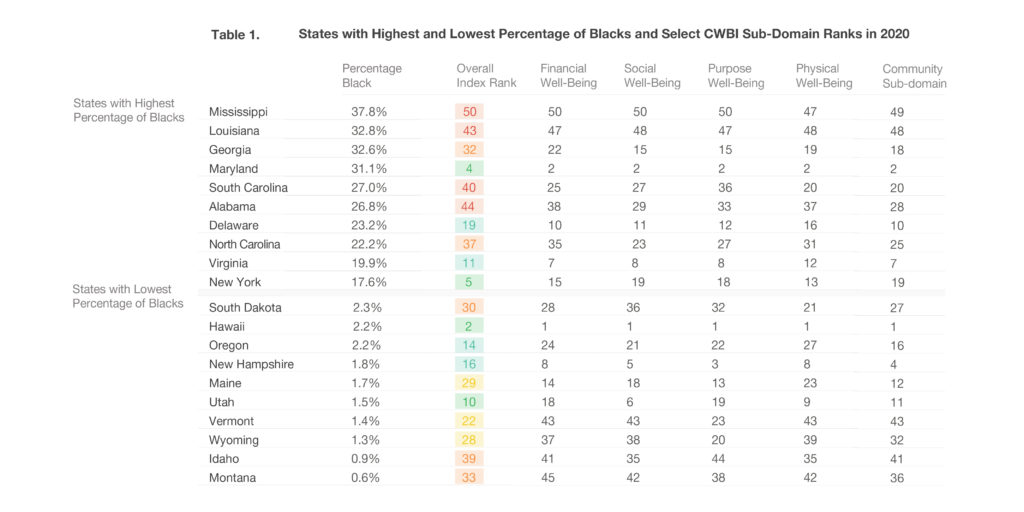Narrowing the Gap
Centuries of pervasive, deeply embedded racism in the United States has had a profound impact on communities of color, adversely affecting their health and overall well-being. Although they experience higher rates of diabetes, blood pressure, obesity, heart disease and asthma, Black Americans have more limited access to health care. They also face social and economic inequities, including worse community housing conditions, more limited access to quality education and food as well as worse job market positions compared to white Americans.
Today, discrimination against Black people continues to contribute to health inequities and shape patterns of health and well-being across the nation.
Understanding Community Well-Being Trends

Sharecare’s Community Well-Being Index (CWBI) is a comprehensive measure comprised of 10 sub-domains that identify individual health risk and opportunity and risk tied to an individual’s surroundings and environment.
For many, identifying well-being inequalities can be more difficult; specifically for individuals who do not identify as Black. In terms of Black populations, the states with the highest percentage of Blacks include (in order from largest to smallest): Mississippi, Louisiana, Georgia, Maryland, South Carolina, Alabama, Delaware, North Carolina, Virginia, and New York. On the contrary, the states with the lowest percentage of Blacks include (in order from largest to smallest): South Dakota, Hawaii. Oregon, New Hampshire, Maine, Utah, Vermont, Wyoming, Idaho, and Montana.

For Sharecare’s 2019 Community Well-Being Index State Rankings, 70% of the states with the highest percentage of Blacks rank in the lowest 30% in terms of the overall Index and financial well-being sub-domain. In addition, half of these states rank in the lowest 30% across social well-being and purpose well-being. Lastly, 40% of states with the highest percentage of Blacks rank in the bottom 20% in terms of the community and physical individual health sub-domains. These findings suggest that areas with the highest percentage of Blacks tend to struggle across different well-being domains.

When comparing the states with the highest percentage of Black residents to the states with the lowest percentage of Blacks in 2019, there is a clear difference in terms of health and well-being rankings. States, such as Hawaii, Utah, New Hampshire and Oregon, not only ranked in the top 10 in terms of overall Community Well-Being Index rankings, but also ranked in the top 10% across multiple health and well-being categories. For other states, though their overall Index ranking in 2019 may not have been in the top 10%, many of their well-being factors rank near the middle of the pack with very few factors dropping into the bottom tier. This dataset indicates a correlation between higher levels of Black populations and lower level of health and wellness scores across the Index sub-domains.
2020 – A Year of Hardship & Progress
The COVID-19 pandemic tested the health and well-being of people across the United States and around the world. While navigating this unprecedented public health crisis, racial and ethnic health disparities were resurfaced. The tragic deaths of George Floyd and Breanna Taylor also sparked a series of civil rights protests against deeply engrained racial discrimination in the United States. Sharecare’s Community Well-Being Index team compared the unique health and well-being trends that occurred in 2020 with the previous year.

For Sharecare’s 2020 Community Well-Being Index State Rankings, there are two states that ranked in the top 10 for the Index in areas with the highest Black population. Maryland, specifically, progressed to new heights over the past year. The state jumped to a top five ranking for the first time and ranked second in each CWBI sub-domain—a massive achievement when compared to 2019.
Mississippi and Louisiana saw little improvement between 2019 and 2020, but Georgia rose nine spots in the overall Index rankings and saw improvements across all 10 sub-domains.
Between 2019 and 2020, both Delaware and Virginia also improved across multiple sub-domains, indicating growth specifically in the northeastern region of the United States. Across every state with a high Black population, there was only one instance where a sub-domain decreased in ranking by double digits from 2019 to 2020. When comparing this to states with a low percentage of Blacks, this stat is nearly the opposite with numerous sub-domains dropping more than 10 spots in 2020.
Among states with the lowest percentage of Blacks, 80% decreased in the Index rankings. Idaho fell 12 ranks, from 27 to 39, between 2019 and 2020. In fact, every sub-domain dropped in rankings by an average of 27 spots.
Social Movement & Unstoppable Momentum
Isaac Newton’s Law of Inertia describes momentum as a driving force to an object migrating from one location to another. In retrospect, the social justice movements of 2020 became the catalyst needed to propel the ideology of equality across health and well-being. Communities around the world have taken notice of the injustices that have occurred throughout U.S. history, and many states are finding ways to ensure that all people are represented equally.
“Combating systemic racism requires aggressive action to address structures, policies, and practices that contribute to the wealth gap, to health disparities, and to inequalities in educational access, outcomes, and beyond,” according to a March 21 statement from The White House.
Sharecare’s Community Well-Being Index data identifies areas of progress across health and well-being domains and creates a blueprint for states to follow to eliminate discriminatory practices. As COVID-19’s grip on the nation loosens, attention must shift to ensuring that all community members have the ability to experience the same caliber of health and wellness opportunities. This effort is not only reserved for individuals of color, but for all those who face barriers to the best available resources based on their identification.
Sources:
American Lung Association. “Current Asthma Demographics.” July 6, 2020.
U.S. Centers for Disease Control and Prevention. “Racism is a Serious Threat to the Public’s Health.” Jul 8, 2021.
Sharecare. Sharecare Community Well-Being Index Overview, 2020 State Rankings Report.” May 25, 2021.
Sharecare. Sharecare Community Well-Being Index, 2019 State Rankings Report.” August 2020.
Snowden, Lonnie R, and Genevieve Graaf. “COVID-19, Social Determinants Past, Present, and Future, and African Americans’ Health.” Journal of racial and ethnic health disparities vol. 8,1 (2021): 12-20. doi:10.1007/s40615-020-00923-3
The White House. “Fact Sheet: U.S. Efforts to Combat Systemic Racism.” March 21, 2021.